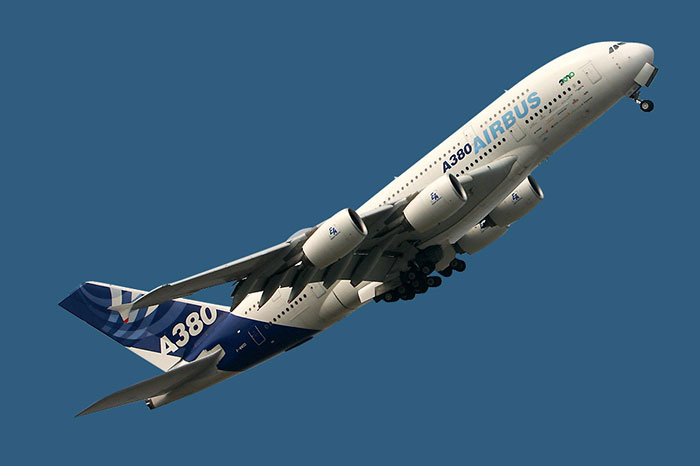2010 (Nov 16-21)
THE 8th China International Aviation & Aerospace Exhibition, widely known as Airshow China 2010, opened on November 16 with 23,000sqm of floor space in three permanent halls and a newly erected temporary hall. Nearly 600 exhibitors from more than 35 countries and territories represented with more than 70 aircraft on display. Approximately 40 summit forums, press conferences, contract-signing ceremonies and product briefings occurred during the show.
![1477736286062058406.jpg Airshow China 2010 opening ceremony [Photo by Cheng Lin]_副本.jpg](http://subsites.chinadaily.com.cn/zhuhai/en/att/20161029/1477736286062058406.jpg)
Airshow China 2010 opening ceremony [Photo by Cheng Lin / Provided to China Daily]
A breakthrough has been seen in domestic participation. Commercial Aircraft Corp of China Ltd (COMAC), had a stand of 1,500sqm to present its image for the first time; the PLA Air Force, a new co-sponsor, was participating with a suite of aircraft that were displayed at the 60th National Day Parade, including the August 1st Aerobatic Team newly equipped with J10 Fighters, and the Parachute Jumping Team.
Airlines from CAAC, China Aviation Industry Corp, China Aerospace Science & Technology Corp, China Aerospace Science & Industry Corp and other sponsors once again displayed their most advanced aviation and aerospace products and technology.
In addition, private aerospace enterprises and aviation industrial parks were showcasing, and most of the regular exhibitors such as Boeing, Airbus, Rolls-Royce and Rosoboronexport increased their display space.
Overseas sales also grew. Moog Inc, Carlisle Interconnect Technologies, Pelican Products Inc, Groen Brothers Aviation Inc, Acciaierie Valbruna SpA, Schmolz-Bickenbach Group, DMG China, Tital GmbH, LLC Research & Production Enterprise PRIMA and FED Corp joined the line-up. After a hiatus of several years, world-famous aviation enterprise Honeywell returned to the Airshow China stage. These new additions were said to greatly enhance the international and professional level of the exhibition while continuing to expand the international influence of Airshow China.
The August 1st team flew newly painted J-10 fighters to stir patriotic fervour with the mighty and heroic spirit of the Chinese air force. Meanwhile, Sherdils aerobatic team of the Pakistan Air Force debuted with nine K-8 trainers, providing a completely new visual impact. They were joined by three JF-17 Fighters of the Pakistan Air Force, one for static display and two for flight demonstrations.
In addition, the Red Eagles Aerobatic Team from the USA gave their excellent show at Airshow China 2010 for the first time.

CASC
CASC showcased the model of Chang’e-2, which was launched on October 1 and went into lunar orbit eight days later. Included in the exhibit were photographs it had sent back and its video image in space. Chang’e-2 is China’s second unmanned lunar probe.
Photographs showing part of the moon’s Sinus Iridum were published by the Chinese State Administration of Science, Technology & Industry for National Defence last Monday.
Unveiled by Premier Wen Jiabao, the photos highlight part of the area proposed for China’s first unmanned soft-landing around 2013. Sinus Iridum is also known as the Bay of Rainbows,
The major mission of the probe is to take high-resolution photos of the lunar surface so as to test technology for Chang’e-3, which would land on the lunar surface and release a moon rover in 2013, a spokesperson noted.
“It is the first time for China to take lunar pictures and release them to the public, and it will surely arouse attention,” he said.
The test orbital module of Shenzhou-7, the core part of the spacecraft, along with a 1:1 model of the re-entry module, gloves used by the taikonauts, and the national flag made a big stir at the previous airshow. Likewise, the lunar photographs and space video on display this time would come to the limelight, he noted.
In addition, CASC displayed a satellite operation sand table with a diameter of 7m, demonstrating the Beidou (compass) navigation satellite system (CNSS), which is the third mature global positioning system only next to the US GPS and Russian GLONASS.
The lunar exploration programme third phase, YH-1 Satellite, Dongfanghong-4 (DFH-4) satellite platform, national disaster contingency rescue on-scene command system and others were also exhibited.
Furthermore, the 1:1 mock-up of the Tiangong-1 target spacecraft was being displayed, its first public presence.
CASIC
With floor exhibition space of 3,000sqmm -- double that of the previous airshow -- CASIC exhibited more than 70 actual objects or models, the largest of this scale in its history.
As the cradle of missiles in China, CASIC showcased a full range of long-distance, short-distance, ground-to-ground and air-to-air multi-layer and functional missiles. In addition, the Blade and Tianying unmanned aerial vehicles (UAV) were also on exhibition.
The Blade, or Knife Point UAV, which made its successful 150km long-distance debut in May 2009, is the most intelligent unmanned aerial vehicle in China. Powered by a 12kw engine with maximum speed in level flight reaching 250kmph, it has a takeoff run of less than 90m.
On the other hand, the Tianying serial multi-functional UAV is composed of a flight platform system, loading system, surface equipment and so on with the minimum fuselage weight of 1.2kg. Thanks to its small volume, light weight and favourable flexibility, Tianying UAV is widely adaptable to ecological environment construction and protection, urban control, serious environmental incidents, traffic control as well as agricultural and tourist development.
Featured too were unmanned craft such as the SH1 UAV, a self-developed and manufactured UAV to survey the extent of damage caused by the Wenchuan and Yushu earthquakes; and the Tianxiang No1, which is the first maritime unmanned climate survey boat in China and was used to conduct metrological sounding mission at Qingdao Sailing Centre during the Beijing 2008 Olympic Games.
The second-generation explosive-removing robot Snow Leopard Robot was also on display.
KJ-200 in spotlight
The KongJing-20 (KJ-200), an airborne early warning and control (AEW&C) aircraft developed by Shaanxi Aircraft Corp as part of its special-purpose aircraft, was on display. Also known as GaoXin 5 within the project, it features a linear-shaped active electronically steered array (AESA) radar similar to the Swedish Ericsson PS-890 Erieye, according to sinodefence.com.
The KJ-200 AEW&C aircraft is based on the Y-8F600 airframe. The aircraft is fitted with western avionics for improved performance. The development of the airframe has been carried out jointly by Shaanxi Aircraft Industry Group Co and the Antonov Design Bureau of Ukraine.
Combining early warning detection, electronic reconnaissance, target identification, information transmission, command and control, the KJ-200 AEW&C aircraft made its debut at the National Day Military Parade in 2009.
COMAC
COMAC showcased an ARJ21-700 regional jet, which performed demonstration flights a full-size mock-up and a 1:10 mock-up of the C919 aircraft, a cockpit simulator of C919, as well as three 1:10 ARJ21 aircraft models, all making their first public presence.
The ARJ21 (Advanced Regional Jet for the 21st Century) is the first passenger jet developed and indigenously produced by China. The baseline model -700 has 70 seats. Cooperating closely with suppliers like GE, Honeywell and Rockwell Collins, COMAC has extensively applied technologies like CFD simulations in designing the ARJ21-700, significantly reducing the time and cost of the product development. Meanwhile, by increasing the fuselage width as well as using advanced systems of flight control, avionics and illumination, the comfort of aircraft passengers has been greatly improved. The best-suited engines also lower the emission rate considerably. All these features effectively make the ARJ21-700 much more advantageous than its competitors.
The С919, C referring both China and COMAC, the first 9 implying everlasting in Chinese whereas the 19 refers to maximum capacity of 190 seats, is the first Chinese-designed large long-haul passenger plane for medium- and long-distance journeys.
China Daily cited a Bloomberg report in which Airbus forecasted that the Asia region alone would buy 8,000 hundred seats and above passenger aircraft valued at $1.2 trillion over the next 20 years. A report by Aviation Industry Corp of China (AVIC) also predicted that airlines in China would buy 2,900 large passenger jetliners before 2028.
With a maximum range of 5,555km, C919 relies a lot on American and French components. COMAC develops technologies where it has the know-how and makes up for the rest with parts from outside companies, which enables it to bypass Boeing and Airbus patents.
The 160-seat jet made its maiden flight in 2014.
AVIC
AVIC China Special Aero-Vehicle Research Institute and AVIC Shijiazhuang Aircraft Industry Co have jointly developed the HO300 light amphibian aircraft. It is designed for both a single pilot and dual-control, and adopts a mid-upper cantilever wing, high-mounted single engine, retractable nose wheel landing gear and hull configuration. The HO300 represents fully owned Chinese intellectual property, and it is the first light amphibian made in the country. Its design and manufacturing conform to CCAR-23-R3 requirements.
The HO300 can take off and land at airports or on simple runways paved with concrete or asphalt. It also can take off from and land on bays, rivers, lakes or reservoirs 800m long, 50m wide and 1.0m deep. It is an ideal aero-vehicle for light operation in plain, inland waters and remote mountain water areas. After simple modification, it can be used for sightseeing, training, sports and entertainment, agriculture-forest operation as well as aerial surveys and photography.
Diamond-Aetna
The Russian leading manufacturer of air defence weapon system, “Diamond – Aetna”, briefed its S-300PMU2 Beloved, Beech-M2E, Doyle-M2E and a series of Russia’s latest air defence missile systems and disseminating information on S-400 Triumph air defence missile systems and other military products at the company’s booth. It also showcased models of the 5P85TE2 launcher unit of the S-300PMU2, various vehicles applied in the Doyle-M1 and Doyle-M2E short-range air defence systems, and automatic firepower strike system, probe and target indication station and launching-loading equipment allocated in the Beech-M2E medium-range air defence missile system.
The S-300PMU2 Favorit air missile system was designed for defence of vital facilities of the state and its armed forces against mass strikes by modem and future aircraft, strategic cruise missiles, tactical and theatre ballistic missiles, and other air attack weapons over a full range of altitudes and speeds in heavy ECM environments. It can engage targets flying from 10m to 27km above the surface at a speed of up to 10,000 km/h. It is claimed that it has a kill ratio ranging from 0.8 to 0.93 against aircraft and from 0.8 to 0.98 against Tomahawk-class cruise missiles.
The S-400 Triumph, a new generation air defence missile systems to ensure destruction of an air force within 400km, can intercept the lowest of the low-flying targets at 5m, regardless speed, altitude or flight path.
Airbus
Airbus showcased its 21st century flagship, the A380, the world’s largest passenger jet, and the new A330-200F freighter at the airshow. It also highlighted its 40 years of innovation and commitment to China, in particular its cooperation with Chinese aviation industry and institutions in the field of research and technology (R&T).
The A380 made its shining debut at the previous airshow two years before, impressing the audience with its size and quietness.
Airbus also had a presence on the EADS (the European Aeronautic Defence & Space Co) stand, located in Exhibition Hall 1. A cutaway model of the A330-200F freighter -- a reference for cabin capacity and versatility in its class, and latest member of the popular A330 Family – was being displayed. Airbus (Beijing) Engineering Centre has been involved in the development of the A330-200F programme by performing six work packages.
Airbus started industrial cooperation with China on delivery of the first aircraft, an A310, to China in 1985. The company now has four joint-ventures with Chinese partners covering training, engineering, final assembly and composite manufacturing, in addition to a number of cooperation projects. Over half of the Airbus worldwide fleet has components produced in China, according to airbus.com.
Bombardier Aerospace
Bombardier highlighted its extensive range of business and commercial aircraft, as well as its customer services portfolio, at this event. The company’s static display featured the midsize Learjet 60 XR, the super midsize Challenger 300 and the large cabin Challenger 850 business jets.
Avicopter
Chinese state-owned helicopter-maker AVIC Helicopter Co Ltd (Avicopter) showcased the AC311, a giant domestic helicopter for civil use with a maximum take-off load of 13.8 tonnes. It made its first public appearance and flew during the airshow. It landed safely after its live-televised debut in Jingdezhen city, Jiangxi province, in mid-March.
The giant helicopter, with a maximum voyage of 900km (559 miles) and a boarding capacity of 27 passengers, was hailed as a breakthrough in domestic aviation technology, which could be employed in earthquake relief.
Avicopter said applications for the locally developed helicopter would include border patrol, law enforcement, disaster relief, emergency rescue, transport, line inspections, air tourism, forest fire fighting, aerial photography and other general aviation services.
Sky filled with breathtaking manoeuvres
August 1st
SIX of the seven People’s Liberation Army Air Force August 1st Aerobatic Team’s J-10 fighters performed 22-minute aerobatic demonstrations daily during the show. The J-10 aircraft were painted dark blue, China red and silver.
The military revised the paint scheme of the J-10 fighter jets in 2009 after many netizens criticized it for being “too garish” and not representative of the plane’s superior performance, according to an officer.
The Central Academy of Fine Arts was selected to carry out the work, and the designer provided three paint schemes featuring a sword, a dragon and a thunderbolt. The sword proved to be the most popular.
Also in the PLA line-up were the J-8F, JH-7A, H-6H, Kongjing-200, Z-8KA and Z-9WA aircraft along with the China Air Force Parachute Squadron that staged aerobatic stunts.
Sherdils
The Sherdils aerobatic team of the Pakistan Air Force consists of six K-8P trainers, of which four performed, one conducted a flying demonstration and the other was for static display.
Officially formed in August 1972, Sherdils is stationed with the Pakistan Air Force Academy in Risalpur. The team was composed of instructors and they used to fly the T-37 Tweety Bird. Over the years the team has performed mostly nationally at the 23rd March parades, academy graduations, and airshows for foreign dignitaries, including heads of state and military officers.
The Pakistan Air Force also sent three JF-17 Thunder fighters, two that performed aerobatic demonstrations and one on static display with weapons.
The JF-17 is a joint Chinese/Pakistan design known as the FC-1 Xiaolong in China developed by the China Aviation Industry Corp (CAIC) and Pakistan industry.
Red Eagle
The Red Eagle Air Sports Team made its maiden flight in China as the airshow opened on November 16 and then gave aerobatic demonstrations once a day.
The team provided eye-popping, spectacular performances featuring a singular blend of low-level precision formation and aerobatics with fascinating transitions and head-on passes.
Dan McClung and partner Buck Roetman, who had a combined 65 years and 37,000 hours of flight experience then, flew the one-of-a-kind Talon Eagle and the Red Eagle to demonstrate inverted flat spins, inside and outside loops, multiple snaprolls, tail slides, plus their signature manoeuvres.
A380
Airbus A380, the world’s largest passenger jet, was on static display and performed seven-minute flying demonstrations on the first two business days. Meanwhile, a 1:20 mock-up of the most up-to-date A330-200F freighter was being showcased at the Airbus’ booth.
The double-decker jetliner, which was developed in France by the multinational European aircraft manufacturer, has a cabin that holds a pub, cinema, resting and business areas. Airlines can use the cavernous hold to provide whatever their imaginations dream up: cafeteria, playroom, nightclub, casino, bedrooms, showers, treadmills, duty-free store, business centre, etc.
In addition, the Bombardier Challenger 604 business jet, Diamond Star DA 40 and DA 42 light aircraft, Cirrus SR22 light aircraft, Gulfstream G200 and G500 business jet, Beechcraft Bonanza G36 and other planes were exhibited.
Other performances
The Bombardier Global Express XRS aircraft, AVIC L-15, AC-313, MA600, LE-500 Little Eagle light aircraft and AC313 helicopter, Antonov’s AN-148 regional jet, Pilatus PC-6 Utility Aircraft, Cirrus SR-22、SR-22T aircraft, Gulfstream G450 aircraft, Embraer’s Legacy650, PLAAF’s JT-6, JT-5, CJ-5, IL-76 aircraft, COMAC ARJ-21 regional jets, Diamond Aircraft’s DA40D gave daily demonstration flights.
Meanwhile, on the 2nd China Aviation Day co-hosted by China Aviation Industry Corp and the People’s Liberation Army Air Force (PLAAF) on November 17, the FC-1 Xiaolong fighter, L15 advanced trainer aircraft, MA600 passenger aircraft, LE-500 Little Eagle light aircraft and AC313 helicopter, the latter making its first flight appearance here, gave aerobatic performances.







